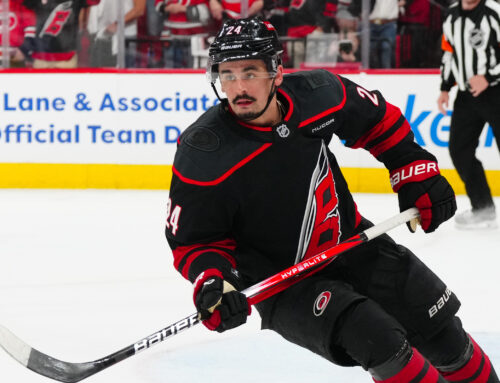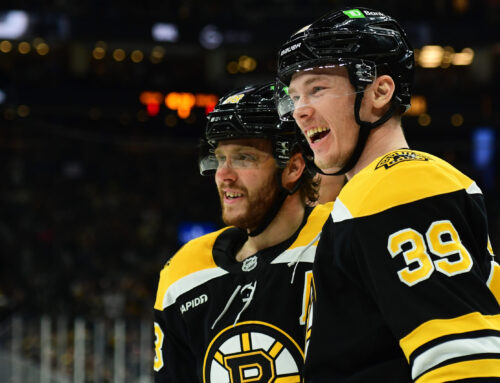
How has the success and failure of these six Eastern Conference teams on the power play affected the fantasy of value of their players?
The most challenging task for fantasy managers at the start of a new season is to process all of the new information available. We all have our projections and expectations going in and we quickly notice a lot of individual starts not going according to plan. Most outliers end up being corrected rather quickly but in some instances the trend will continue. Thankfully there are metrics to help distinguish between fact and fiction.
After spending the last two weeks analyzing hot and cold starts for forwards and defensemen using primarily even strength numbers, this week we shift to the power play. The man advantage obviously produces situations that facilitate goal scoring and is a great source for points for those that see a lot of power play minutes and play with great linemates. On the other hand, power plays run hot and cold in part due to the lack of overall time in such situations.
Given the impact of power-play points on the overall point total of fantasy-relevant players, today we will cover six teams in the Eastern Conference. This includes the top two in efficiency, the bottom two and a pair of interesting teams doing well with the man advantage out of the gate. We will look at individual power-play points, time on ice with the man advantage, the percentage of the overall available power-play minutes spent on the ice, the on-ice shooting percentage and some numbers from last year for comparison.
Boston Bruins (33.3% – first overall)
|
Player |
PPP |
PPTOI |
%PP |
PPSH% |
14-15 PPTOI |
14-15 %PP |
|
9 |
3:12 |
62.6 |
23.9 |
2:20 |
51.7 |
|
|
8 |
3:39 |
71.5 |
22.0 |
2:13 |
52.1 |
|
|
6 |
3:16 |
63.8 |
25.5 |
2:24 |
53.4 |
|
|
6 |
3:33 |
69.4 |
19.6 |
2:36 |
57.9 |
|
|
4 |
1:42 |
32.5 |
46.1 |
2:05 |
44.4 |
|
|
3 |
1:39 |
31.0 |
25.0 |
0:59 |
21.8 |
|
|
Colin Miller |
3 |
1:18 |
24.9 |
44.4 |
– |
– |
|
3 |
3:12 |
62.7 |
18.1 |
2:43 |
50.7 |
The Bruins have been lights out on the power play which has contributed greatly to their gaudy offensive output thus far. In particular, Krejci currently sits in a tie for fourth among all NHL players in points this year. The catch is the Bruins have benefited from some very high shooting percentages on the man advantage. In fact, Chara and Miller currently sit above the 40-percent mark! Look for this rate to drop significantly in the coming months. They will be more potent than they were last year but it is unlikely they will continue to set the standard for power-play efficiency.
The good news for the Bruins is the production on the power play has gone beyond the first unit. This will help pad the numbers for guys like Marchand, who had two power-play points all of last year, and Chara who had just five last year. With that said, look for the bulk of the points to go to the top unit given their heavy utilization.
Buffalo Sabres (22.9% – fifth overall)
|
Player |
PPP |
PPTOI |
%PP |
PPSH% |
14-15 PPTOI |
14-15 %PP |
|
7 |
3:11 |
54.7 |
15.9 |
2:38 |
51.8 |
|
|
4 |
2:37 |
45.2 |
17.1 |
2:00 |
42.8 |
|
|
3 |
2:41 |
46.3 |
11.8 |
– |
– |
|
|
3 |
3:05 |
53.1 |
12.5 |
2:32 |
45.2 |
|
|
3 |
2:42 |
49.4 |
11.1 |
2:04 |
43.3 |
The Sabres’ top offseason acquisitions have delivered, especially O’Reilly who leads the pack with seven power-play points. The on-ice shooting percentages are much more normal than they are for the Bruins which make this trend more likely to continue. To be fair, this group could get even better as Eichel and Ristolainen improve and help generate more scoring chances.
Surprisingly, the Sabres have shown some good balance offensively. Beyond the five names listed here, the next five (Tyler Ennis, Marcus Foligno, Evander Kane, Matt Moulson and Jamie McGinn) have two power-play points each. Look for them to surpass Gionta on this chart soon as the 36-year-old is more valued for his leadership than his on-ice play at this point in his career.
Carolina Hurricanes (13.0% – 27th overall)
|
Player |
PPP |
PPTOI |
%PP |
PPSH% |
14-15 PPTOI |
14-15 %PP |
|
5 |
3:27 |
61.8 |
11.9 |
2:43 |
54.9 |
|
|
4 |
3:00 |
53.8 |
11.1 |
1:47 |
32.7 |
|
|
3 |
2:53 |
51.5 |
8.3 |
2:30 |
50.4 |
|
|
2 |
3:23 |
60.3 |
12.2 |
2:36 |
52.9 |
The Hurricanes have been able to get good production out of a couple players despite weak on-ice shooting percentages and a poor overall efficiency. Faulk, last year’s big breakout player for the Canes, is off to a great start but the team’s franchise player Staal has been just average. Getting the captain back on track would help give the percentages a boost which can only help the support players like Versteeg and Rask who are both off to great starts as well.
The biggest red flag is the lack of support scoring although that is not a surprise given the team’s lack of depth. Beyond the four mentioned here the production dries up quickly. This includes fantasy-relevant players such as Jeff Skinner and Jordan Staal who have yet to contribute with the man advantage. It is not surprising that their respective starts to the year have been poor.
Montreal Canadiens (27.3% – third overall)
|
Player |
PPP |
PPTOI |
%PP |
PPSH% |
14-15 PPTOI |
14-15 %PP
📢 advertisement:
|
|
7 |
3:25 |
62.7 |
20.8 |
3:15 |
66.6 |
|
|
6 |
4:01 |
73.7 |
22.4 |
3:41 |
74.3 |
|
|
5 |
2:34 |
47.3 |
29.0 |
2:27 |
49.3 |
|
|
5 |
2:39 |
48.6 |
28.1 |
2:11 |
44.1 |
|
|
4 |
2:23 |
43.7 |
18.8 |
2:13 |
44.5 |
|
|
4 |
2:02 |
37.4 |
29.4 |
1:17 |
25.4 |
|
|
3 |
1:51 |
34.0 |
20.0 |
2:23 |
48.1 |
|
|
3 |
2:37 |
51.1 |
27.3 |
2:35 |
52.4 |
The Canadiens have been the best team in the league so far. The biggest surprise has been their offensive surge as they have scored more goals than any other team after being a low-scoring team last year. The team’s great chemistry has carried over to their power-play production where they sit third by scoring on 27 percent of opportunities.
Like the Bruins, the Canadiens have benefited from some elevated on-ice shooting percentages. This is bound to drop across the board and will affect all players except Pacioretty who has actually been a bit unlucky collecting just three power-play points while his linemates have enjoyed more success. It is also worth noting that while Galchenyuk has successfully shifted to center, he is not in a top-line role. The second power-play unit has been strong so far but being in a secondary role limits his upside for the time being.
New Jersey Devils (21.6% – ninth overall)
|
Player |
PPP |
PPTOI |
%PP |
PPSH% |
14-15 PPTOI |
14-15 %PP |
|
7 |
2:33 |
47.5 |
21.9 |
1:43 |
37.4 |
|
|
5 |
2:18 |
44.7 |
24.0 |
1:59 |
45.4 |
|
|
4 |
3:09 |
58.7 |
15.4 |
2:11 |
51.4 |
|
|
3 |
1:55 |
35.9 |
31.3 |
2:13 |
48.4 |
|
|
3 |
2:18 |
42.8 |
19.4 |
0:31 |
12.4 |
|
|
3 |
2:43 |
50.5 |
15.8 |
0:55 |
18.6 |
The Devils have greatly exceeded expectations so far this year after many predicted they would finish in the cellar of the NHL standings. Their power play has been a big part of their offense generating more goals than we thought. While this is a great story, the power play is unlikely to continue lighting the lamp at this rate.
In particular, Palmieri, Zajac, Gelinas and Josefson have benefited from luck with the man advantage. The former two should remain viable options for power-play points but should not be expected to continue at their rapid rate. Meanwhile, the latter two should be considered risks to go cold as they continue to show inconsistencies as offensive players.
While the Devils continue to run their power play with four forwards, there should be plenty of opportunities for the Devils’ forwards to continue producing. Meanwhile, the use of an extra forward hurts defensemen like Gelinas, Adam Larsson and Damon Severson.
Philadelphia Flyers (13.9% – 26th overall)
|
Player |
PPP |
PPTOI |
%PP |
PPSH% |
14-15 PPTOI |
14-15 %PP |
|
4 |
3:26 |
62.9 |
6.7 |
3:18 |
64.0 |
|
|
3 |
2:58 |
54.4 |
10.8 |
2:59 |
58.0 |
|
|
3 |
3:42 |
67.7 |
6.7 |
3:35 |
69.9 |
|
|
2 |
3:20 |
61.2 |
7.0 |
3:09 |
61.2 |
|
|
2 |
3:27 |
63.4 |
6.8 |
3:16 |
63.5 |
The Flyers have not enjoyed a good start to the season primarily due to their lack of goal-scoring. This is surprising given the presence of elite point-producers Giroux and Voracek in their lineup. Thankfully, there is plenty of evidence that their power play is due for some improvement.
The Flyers’ big guns have been grossly unlucky on the power play this year with everyone but Schenn sporting an on-ice shooting percentage of seven percent or worse. The top unit is due for an increase which will help correct the numbers of some of their slow starters. Beyond these five the production dries off quickly. Until that changes the likes of Michael Del Zotto and Sam Gagner have limited ceilings.
*
Follow me on Twitter @DH_EricDaoust and be sure to check out Frozen Pool as features continue to be improved every week. Recently added to Player Profile pages include historical advanced stats, yearly salaries and cap hits.





 FLA
FLA EDM
EDM CHI
CHI N.J
N.J BUF
BUF NYI
NYI WSH
WSH UTA
UTA MIN
MIN BOS
BOS
